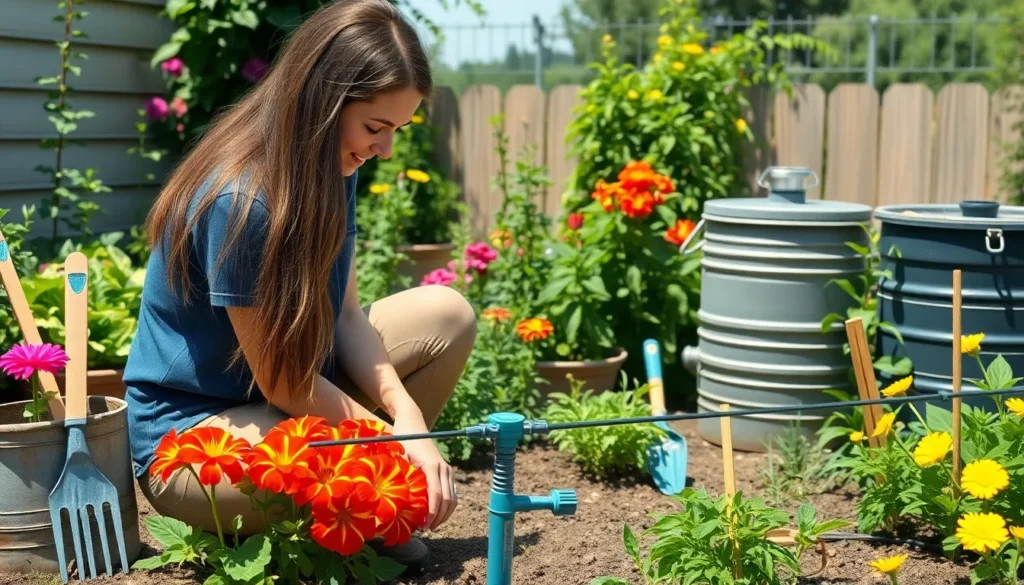We’ve all been there – standing in our gardens with a hose in hand wondering if there’s a smarter way to keep our plants thriving. The truth is traditional watering methods often waste water and leave us feeling like we’re fighting a losing battle against thirsty plants and rising utility bills.
Smart irrigation isn’t just about convenience anymore. It’s about creating sustainable gardens that flourish while saving time money and precious water resources. Whether you’re dealing with sprawling vegetable beds or compact container gardens the right irrigation system can transform your gardening experience from a daily chore into a well-oiled operation.
From simple DIY drip systems to high-tech smart sprinklers we’re about to explore game-changing irrigation ideas that’ll revolutionize how you water your garden. These answers work for every budget and skill level proving that efficient watering doesn’t have to be complicated or expensive.
Drip Irrigation Systems for Efficient Water Distribution
Drip irrigation transforms how we deliver water directly to plant roots, eliminating the wasteful spray patterns of traditional sprinklers. This targeted approach reduces water consumption by up to 50% while ensuring every plant receives the exact moisture it needs.
Micro-Drip Emitters for Precise Plant Watering
Micro-drip emitters deliver water at flow rates between 0.5 to 4 gallons per hour, making them perfect for individual plants and containers. We position these small devices directly at the base of each plant, where they release slow, steady drops that penetrate deep into the root zone.
Installing micro-drip emitters requires connecting them to a main supply line using ¼-inch tubing. Each emitter can be adjusted or replaced independently, allowing us to customize water delivery for plants with different moisture requirements. Tomatoes and peppers thrive with 2-gallon-per-hour emitters, while herbs and succulents need only 0.5-gallon rates.
Pressure-compensating emitters maintain consistent flow rates even when water pressure fluctuates throughout the system. We recommend these premium options for gardens with elevation changes or long irrigation runs exceeding 100 feet.
Soaker Hoses for Garden Bed Coverage
Soaker hoses provide uniform water distribution across entire garden beds through thousands of tiny pores along their length. We lay these porous tubes directly on soil surfaces or bury them 2-3 inches deep for maximum efficiency.
Standard soaker hoses work effectively for runs up to 100 feet, delivering approximately 1 gallon per hour per linear foot. We space multiple hoses 12-18 inches apart in wide garden beds to ensure complete coverage without creating dry spots between rows.
Recycled rubber soaker hoses last 3-5 years under normal conditions, while fabric versions typically need replacement after 2 seasons. We cover soaker hoses with 2-4 inches of mulch to prevent UV damage and reduce evaporation by up to 30%.
Installing soaker hoses requires connecting them to standard garden hoses or permanent irrigation lines using simple threaded fittings. We create loops or serpentine patterns around plants to maximize water coverage while maintaining proper spacing guidelines.
Automated Timer Controls for Consistent Scheduling
Automated timer controls eliminate guesswork by delivering water at optimal times without daily intervention. We program these devices to run irrigation cycles during early morning hours when evaporation rates are lowest and plant uptake is highest.
Digital timers offer multiple programming options, including daily, every-other-day, or custom weekly schedules. Basic models provide 1-4 watering zones, while advanced controllers manage up to 16 separate irrigation circuits for complex garden layouts.
Smart irrigation timers connect to local weather stations and adjust watering schedules based on rainfall, temperature, and humidity data. We save an additional 15-20% on water usage by allowing these systems to skip irrigation cycles during rainy periods or reduce runtime during cooler weather.
Battery-powered timers work independently of electrical connections, making them ideal for remote garden locations. We replace standard AA batteries annually, though some models feature solar charging capabilities that eliminate battery maintenance entirely.
Sprinkler Solutions for Large Garden Areas
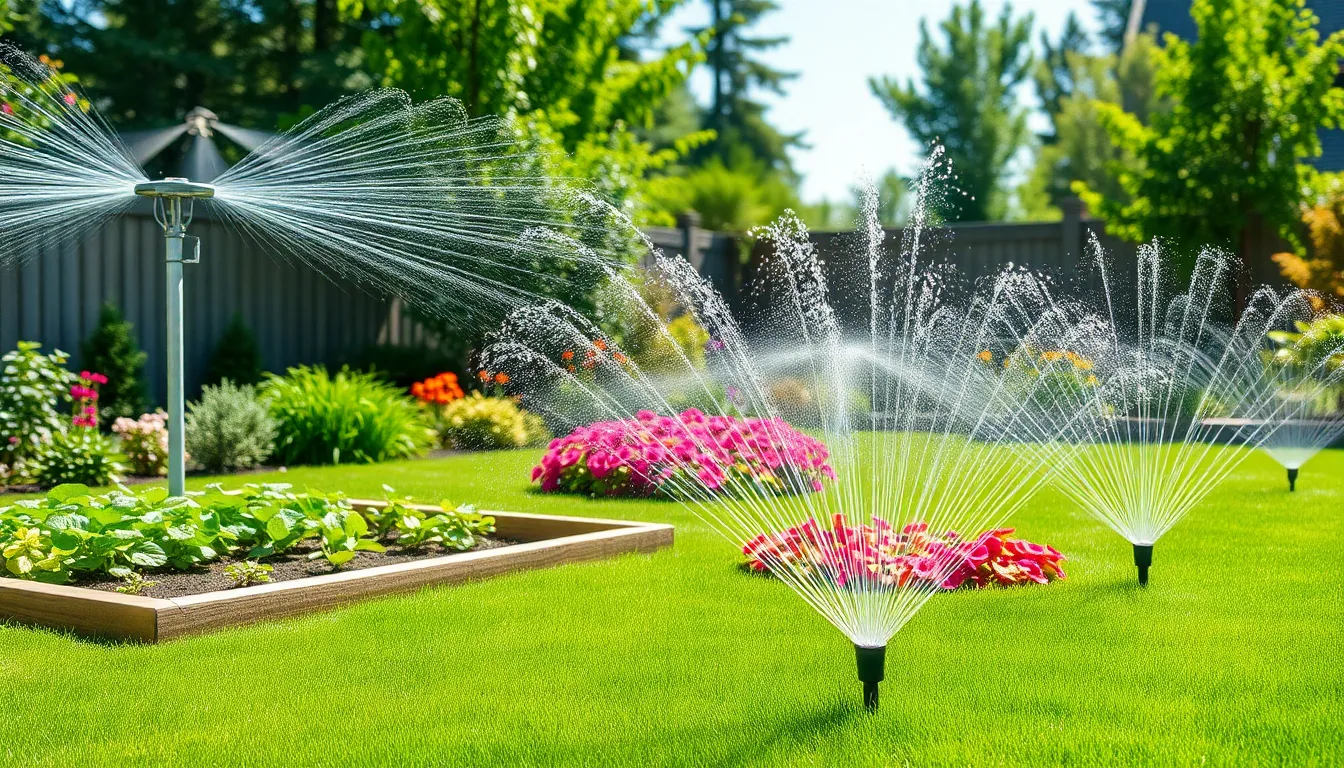
For expansive garden spaces where drip irrigation isn’t practical, sprinkler systems offer efficient coverage that can water large areas quickly and effectively.
Oscillating Sprinklers for Rectangular Plots
Oscillating sprinklers move back and forth to create consistent water coverage across rectangular garden areas. We find these systems particularly effective for large lawns and vegetable gardens with straight borders. These sprinklers distribute water in an adjustable pattern that matches exact garden shapes perfectly.
Most oscillating models cover areas ranging from 1,200 to 4,000 square feet depending on water pressure and nozzle settings. We recommend positioning them centrally within your rectangular plot to ensure even coverage. Adjustable width controls let you customize the spray pattern to avoid watering walkways or neighboring properties.
Rotating Sprinklers for Circular Coverage
Rotating sprinklers spin continuously to deliver water across circular garden areas with uniform distribution. We prefer these systems for round lawn sections and curved garden beds where traditional rectangular coverage creates gaps. These versatile sprinklers work effectively in various garden layouts and terrain types.
Coverage areas typically range from 20 to 65 feet in diameter based on water pressure and sprinkler head design. We suggest installing multiple rotating sprinklers for overlapping coverage in larger circular spaces. Impact driven models provide the longest range while gear driven options offer quieter operation for residential settings.
Pop-Up Sprinkler Systems for Seamless Lawn Integration
Pop-up sprinkler systems retract completely underground when not in use, maintaining clean lawn appearance without visible obstacles. We install these systems for homeowners who want professional irrigation without compromising their industry aesthetics. These sprinklers pop up automatically during watering cycles and disappear afterward.
Underground installation requires initial trenching but provides permanent irrigation infrastructure for large properties. We typically space pop-up heads 15 to 30 feet apart depending on coverage radius and water pressure. Smart controllers can program these systems to operate during optimal morning hours when evaporation rates remain lowest.
Rain Water Harvesting Methods for Sustainable Irrigation
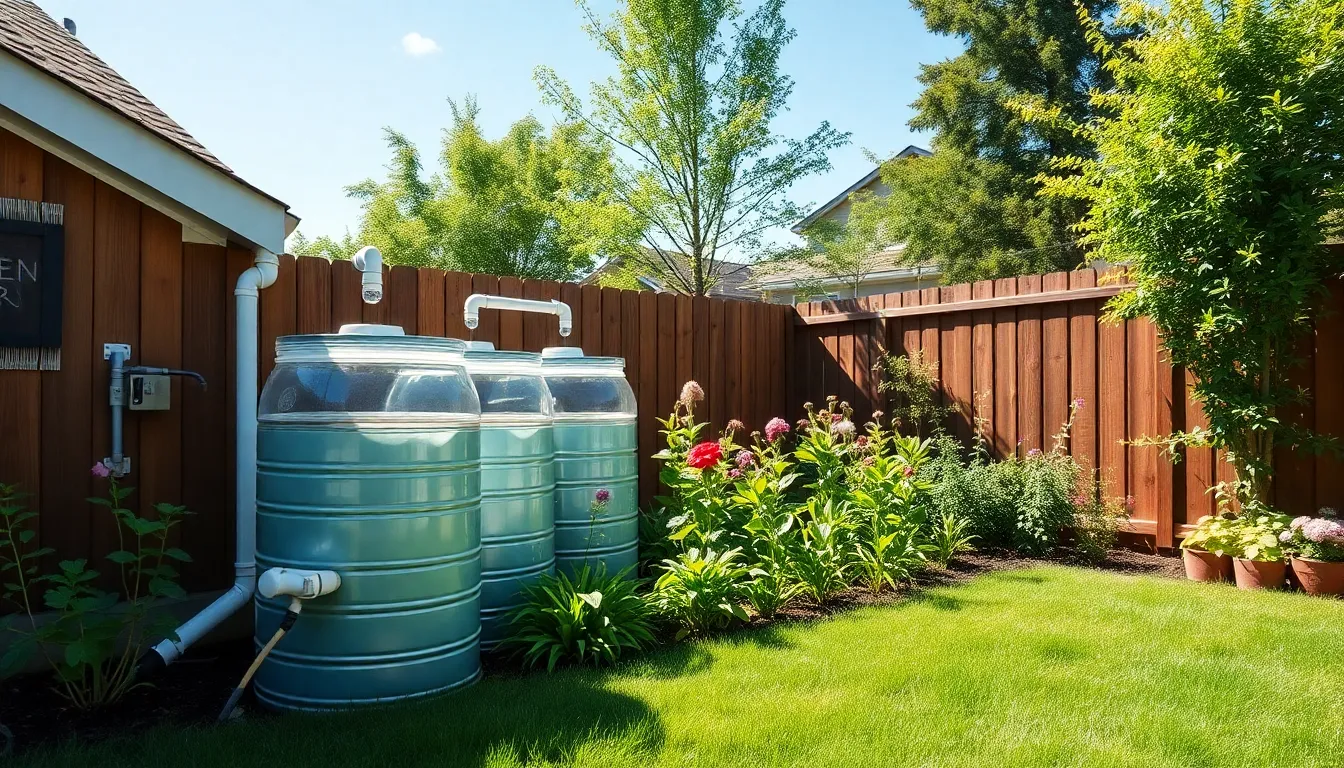
Rainwater harvesting transforms free precipitation into a sustainable irrigation resource that reduces municipal water demands while providing chemical-free hydration for our plants. We can carry out various collection methods that range from simple barrel systems to comprehensive storage answers.
Rain Barrel Collection Systems
Rain barrels serve as the most accessible entry point for residential rainwater collection, capturing runoff from rooftops through strategically placed containers. We can connect multiple barrels together to increase our storage capacity, making these systems ideal for small to medium-sized gardens that require consistent moisture levels.
Installation becomes straightforward when we position barrels beneath downspouts and connect them to gravity-fed drip irrigation systems for automated plant watering. Our collected rainwater supplies both handheld watering cans and hose attachments, providing flexibility for different garden zones and plant requirements.
Linking multiple rain barrels creates an expandable network that grows with our gardening needs while maintaining the simplicity of the original system. We optimize water distribution by installing spigots at various heights on our barrels, allowing complete drainage and maximum water utilization.
Cistern Storage for Extended Dry Periods
Cisterns provide substantial rainwater storage that extends well beyond what traditional rain barrels can offer, making them essential for regions with prolonged dry seasons. We can store thousands of gallons in underground or above-ground cisterns, ensuring continuous irrigation during extended periods without rainfall.
Commercial-grade cisterns serve large residential properties and agricultural applications where water security becomes critical for plant survival. Our cistern systems integrate with existing irrigation networks, providing pressurized water distribution that rivals municipal supply systems.
Underground cistern installation protects stored water from temperature fluctuations and evaporation while preserving valuable garden space above ground. We maximize collection efficiency by connecting cisterns to multiple downspouts and implementing first-flush diverters that improve water quality.
Gutter Diversion Techniques
Gutter systems form the foundation of effective rainwater collection by channeling roof runoff into our storage containers with minimal water loss. We maintain clean gutters and properly sloped installations to ensure maximum water capture during precipitation events.
Downspout diverters redirect water flow from traditional drainage paths into our collection systems, preventing valuable rainwater from becoming unusable stormwater runoff. Our diverter installations include shut-off mechanisms that allow normal drainage when storage containers reach capacity.
First-flush diverters improve water quality by discarding the initial roof runoff that contains debris and contaminants before clean water enters our storage systems. We position these devices strategically to capture the cleanest possible rainwater while maintaining efficient collection rates throughout each storm event.
Self-Watering Container Systems for Potted Plants
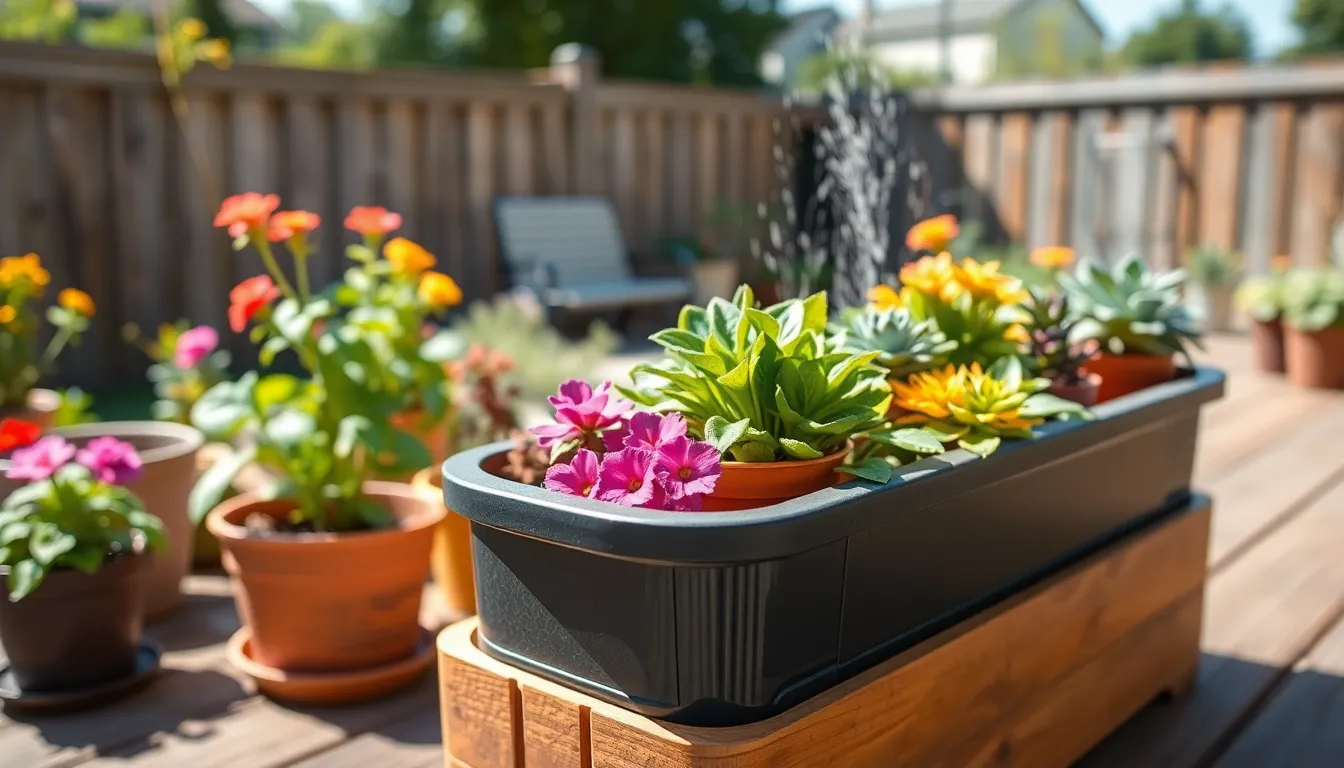
Moving beyond traditional garden irrigation, we explore container answers that bring sophisticated watering directly to our potted plants. These systems eliminate the guesswork from container gardening while ensuring consistent moisture levels.
Reservoir-Based Planters with Wicking Systems
Reservoir-based planters revolutionize container gardening by utilizing wicking mechanisms that draw water from bottom reservoirs to soil level. These innovative systems maintain consistent moisture without overwatering or excessive evaporation, making them perfect for plants that require steady hydration.
We can create DIY versions using plastic buckets and PVC pipes, transforming ordinary containers into efficient self-watering systems. The wicking action works continuously, allowing plants to access water as needed while preventing root rot from standing water.
Commercial options from brands like ePlanters offer professionally designed reservoir systems that reduce watering frequency significantly. These planters work exceptionally well for herbs, vegetables, and flowering plants that demand consistent soil moisture throughout their growing season.
Bottle Irrigation Methods for Budget-Friendly Options
Bottle irrigation transforms everyday plastic bottles into effective mini-reservoirs for our container gardens. This cost-effective method involves burying bottles alongside plants, where they release water slowly as surrounding soil dries out.
We simply puncture small holes in plastic bottles, fill them with water, and position them strategically near plant roots. The system provides gradual moisture release over several days, making it ideal for weekend gardeners or vacation watering.
Different bottle sizes accommodate various plant needs, from small herb containers requiring 16-ounce bottles to larger planters benefiting from 2-liter containers. This method costs virtually nothing while delivering reliable irrigation results.
Smart Pot Technologies with Moisture Sensors
Smart planters integrate advanced moisture sensors that monitor soil conditions continuously, representing the cutting edge of container irrigation technology. These systems automatically adjust watering schedules based on real-time plant needs rather than predetermined timers.
LetPot’s smart planters exemplify this technology, offering app-controlled irrigation that responds to actual soil moisture levels. Users receive notifications about watering needs and can monitor plant health remotely through smartphone applications.
| Smart Planter Feature | Benefit |
|---|---|
| Moisture sensors | Real-time soil monitoring |
| App connectivity | Remote monitoring and control |
| Automated watering | Eliminates guesswork |
| Data tracking | Plant health insights |
These advanced systems learn individual plant requirements over time, optimizing water delivery for maximum growth while preventing both drought stress and overwatering damage.
Gravity-Fed Irrigation Techniques for Sloped Gardens
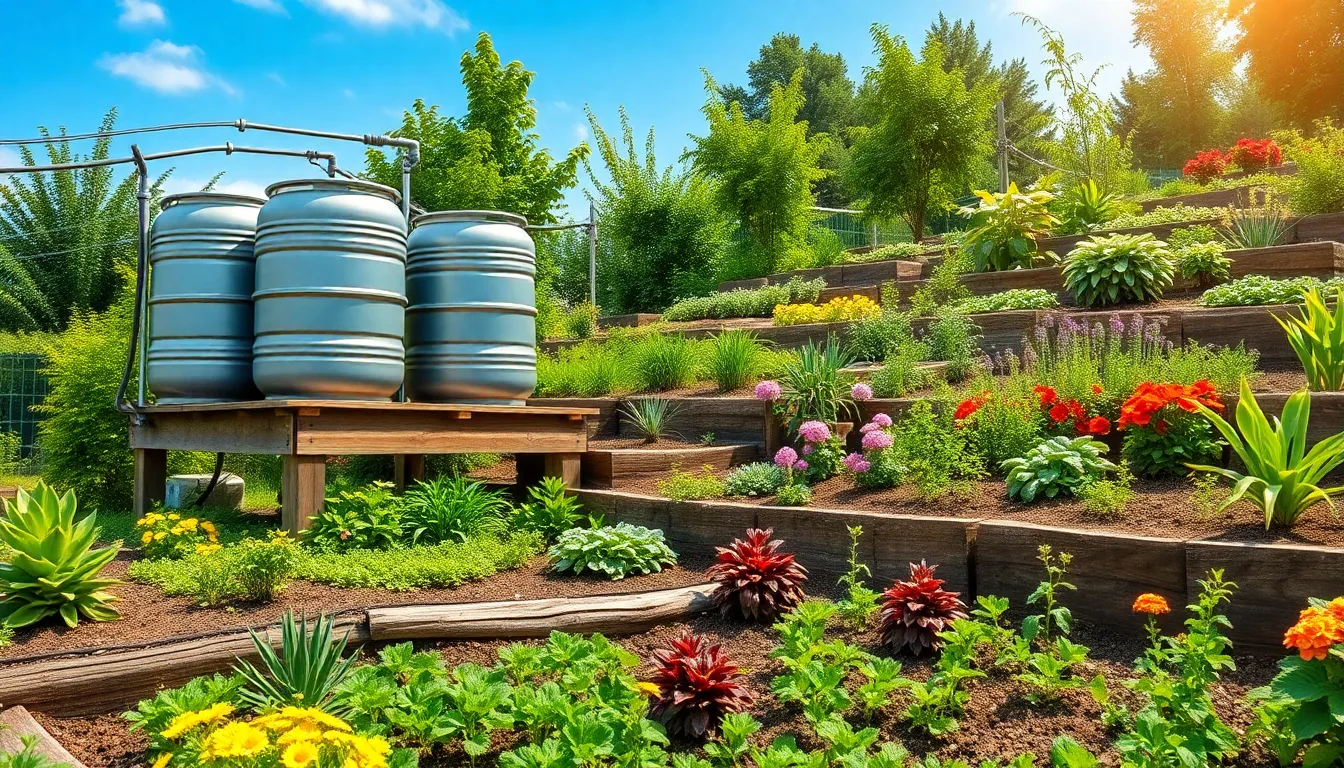
Harnessing the natural power of gravity transforms challenging sloped terrain into efficient watering opportunities. We’ve discovered that gravity fed irrigation systems eliminate the need for pumps or electricity while reducing soil erosion through controlled water pressure.
Elevated Water Tank Systems
Positioning water tanks at higher elevations creates the perfect foundation for gravity powered irrigation. We recommend establishing at least 10 feet of elevation difference between your water source and the irrigation area for optimal performance. This height differential generates the necessary water pressure to distribute moisture effectively throughout your sloped garden.
Rainwater harvesting through elevated rain barrels maximizes your gravity fed system’s potential. Setting up these collection points at the highest areas of your property captures free precipitation while reducing municipal water demands. Multiple barrels can connect together to increase storage capacity and provide continuous water supply during dry periods.
Tank placement strategies make all the difference in system efficiency. We suggest installing your elevated tanks on sturdy platforms or hillside locations that take advantage of natural topography. These positioning choices ensure consistent water flow and eliminate the need for expensive pumping equipment.
Terraced Garden Watering Answers
Creating leveled areas on slopes revolutionizes water distribution and prevents costly erosion. Terracing allows water to spread evenly across each planted level rather than rushing downhill and washing away valuable topsoil. We’ve found this method particularly effective for vegetable gardens and ornamental plantings on steep terrain.
Drip irrigation systems integrate seamlessly with terraced gardens for maximum efficiency. Installing drip lines along each terrace level ensures precise water delivery while minimizing runoff. This combination reduces water waste by up to 50% compared to traditional sprinkler methods and keeps moisture exactly where plants need it most.
Retaining walls and planted barriers enhance terrace watering effectiveness. These structures help capture and slow water movement while creating distinct growing zones for different plant types. We use materials like stone, timber, or concrete blocks to build these barriers based on garden aesthetics and budget considerations.
Gravity Drip Lines for Hillside Plantings
Gravity drip irrigation delivers controlled watering without pumps for hillside installations. This method proves especially beneficial for slope gardens because it effectively manages water runoff while providing consistent moisture to plant roots. We’ve seen excellent results with this approach on grades ranging from gentle slopes to steep hillsides.
Pressure compensating emitters maintain uniform water flow across varying elevations. These specialized components ensure each plant receives equal amounts of water regardless of its position on the slope. Installing these emitters prevents higher elevation plants from receiving less water while lower areas get flooded with excess moisture.
Strategic line placement maximizes gravity drip system performance on hillsides. We recommend running main supply lines along contour lines to maintain consistent pressure throughout the system. Branch lines can then extend downhill to individual plants or planting zones, creating efficient water pathways that work with natural topography rather than against it.
Smart Irrigation Technology for Modern Gardens
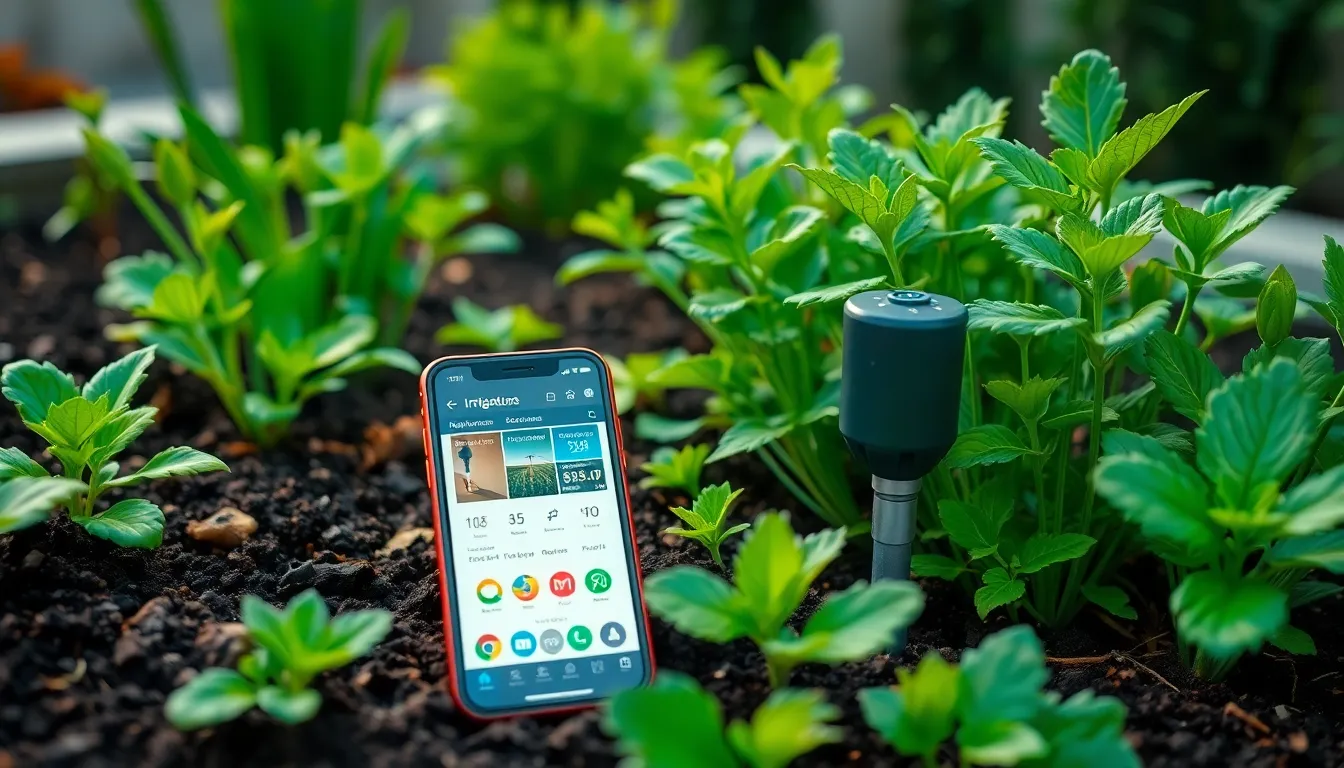
Technology transforms traditional watering routines into precision controlled systems that maximize efficiency while minimizing waste. Modern smart irrigation answers combine sensors, weather data, and mobile connectivity to create responsive watering networks.
Soil Moisture Sensor Integration
Soil moisture sensors monitor ground conditions continuously to determine exactly when your plants need water. These intelligent devices prevent overwatering by automatically overriding scheduled irrigation cycles when soil moisture levels remain adequate. Installing sensors near the root zone provides the most accurate readings for optimal plant health.
Placement depth varies based on plant size and root system development. Small plants require sensor placement at 6 to 12 inches deep while larger plants need monitoring at 18 to 24 inches below surface level. Proper positioning ensures sensors capture moisture data where roots actively absorb water.
Integration with existing irrigation systems allows sensors to communicate directly with controllers and valves. This connection enables automatic adjustments that respond to real soil conditions rather than predetermined schedules. Your garden receives precisely the right amount of water based on actual plant needs.
Weather-Based Automatic Controllers
Weather-based controllers access real-time meteorological data from local weather stations and online services to adjust irrigation schedules automatically. These systems prevent unnecessary watering during rain events or freezing conditions that could damage plants or waste resources. Controllers can reduce water usage by up to 30% compared to traditional timer-based systems.
Local weather station integration provides hyperlocal data that reflects conditions specifically in your area. Controllers receive updates on temperature, humidity, wind speed, and precipitation forecasts to make informed watering decisions. This precision eliminates the guesswork involved in manual schedule adjustments.
Combining weather data with soil moisture sensors creates a comprehensive irrigation management approach. Controllers evaluate both atmospheric conditions and ground moisture levels before activating watering cycles. This dual data approach ensures plants receive optimal hydration while preventing waste from environmental factors.
Smartphone App-Controlled Systems
Smartphone apps provide remote monitoring and control capabilities for modern irrigation systems from anywhere with internet connectivity. Users can adjust watering schedules, monitor soil moisture levels, and receive real-time notifications about system status. These applications transform irrigation management into a convenient mobile experience.
Real-time notifications keep gardeners informed about critical system events and plant conditions. Apps send alerts when soil moisture drops below optimal levels or when weather conditions affect scheduled watering. Users can respond immediately to changing conditions without being physically present in their gardens.
Automation features allow apps to make decisions independently based on preset parameters and integrated sensor data. Systems can automatically adjust schedules according to weather forecasts, soil moisture readings, and seasonal plant requirements. This intelligent automation reduces manual intervention while maintaining optimal growing conditions for your plants.
DIY Budget-Friendly Garden Irrigation Ideas
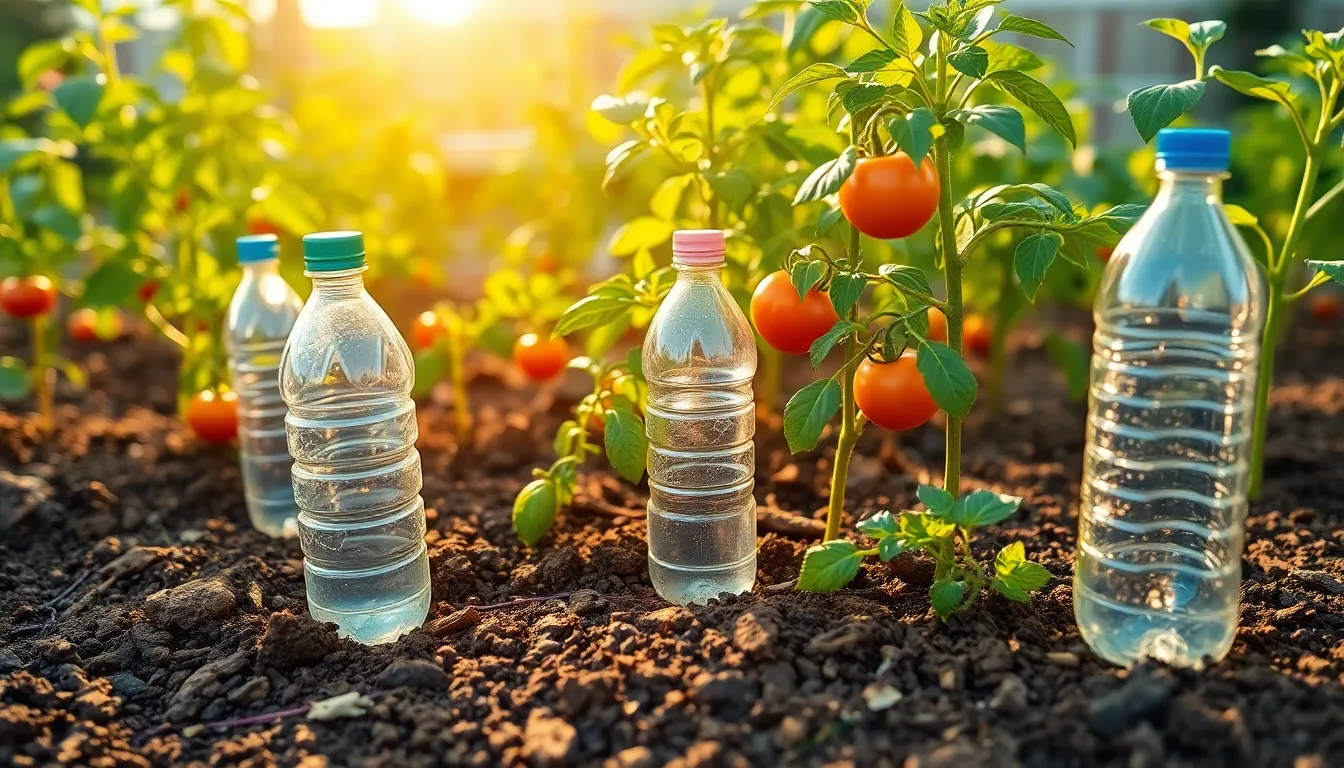
Creating effective irrigation systems doesn’t require expensive equipment or professional installation. We’ll explore three proven DIY methods that use common materials to deliver consistent watering while keeping costs minimal.
Plastic Bottle Drip Systems
Recycled plastic bottles transform into efficient drip irrigation systems that deliver water directly to plant roots. We can create these systems using clean 2-liter soda bottles and basic household tools. Puncturing 10-15 small holes in the bottom half of each bottle creates the perfect flow rate for gradual water release.
Materials we need include clean plastic bottles, a nail or drill for hole-making, and optional socks or nylon for filtration. Placing bottles inside socks prevents soil particles from clogging the holes and extends system lifespan. We position each bottle near target plants with the neck above soil level to maintain consistent water pressure.
Controlling water flow becomes simple by adjusting bottle caps tightness. Loosening caps increases flow rates while tightening them reduces water output. This method works exceptionally well for tomatoes, peppers, and other plants requiring steady moisture levels.
PVC Pipe Sprinkler Networks
PVC pipes create customizable sprinkler systems that cover large garden areas efficiently. We design these networks by laying pipes throughout garden beds and connecting sprinkler heads at strategic intervals. Standard 1/2-inch PVC pipes provide adequate water pressure for most residential applications.
Installation requires PVC pipes, T-joints, elbow fittings, and spray heads suited to our coverage needs. We connect pipes using standard plumbing fittings and position sprinkler heads to eliminate dry spots. Adjustable spray heads allow us to modify coverage patterns based on plant spacing and water requirements.
Network expansion becomes straightforward by adding additional pipe sections and sprinkler heads. We can incorporate timers and pressure regulators to enhance system performance. This approach works particularly well for vegetable gardens and flower beds requiring uniform water distribution.
Ollas (Clay Pot) Buried Irrigation Method
Unglazed clay pots buried near plants provide ancient irrigation technology that conserves water remarkably. We bury these porous containers with only the neck exposed above soil level, then fill them with water for gradual seepage. This method reduces water usage by up to 70% compared to surface watering.
Selecting appropriate pot sizes depends on plant water needs and root zone coverage. Small 6-inch pots work well for individual plants while larger 12-inch containers serve multiple plants or larger specimens. We space ollas 18-24 inches apart for optimal coverage in garden beds.
Maintenance involves refilling pots weekly and cleaning mineral deposits from clay surfaces. Clay naturally filters water while releasing moisture based on soil conditions around each pot. This self-regulating system prevents overwatering and ensures plants receive consistent hydration throughout growing seasons.
Mulching Strategies to Enhance Irrigation Efficiency
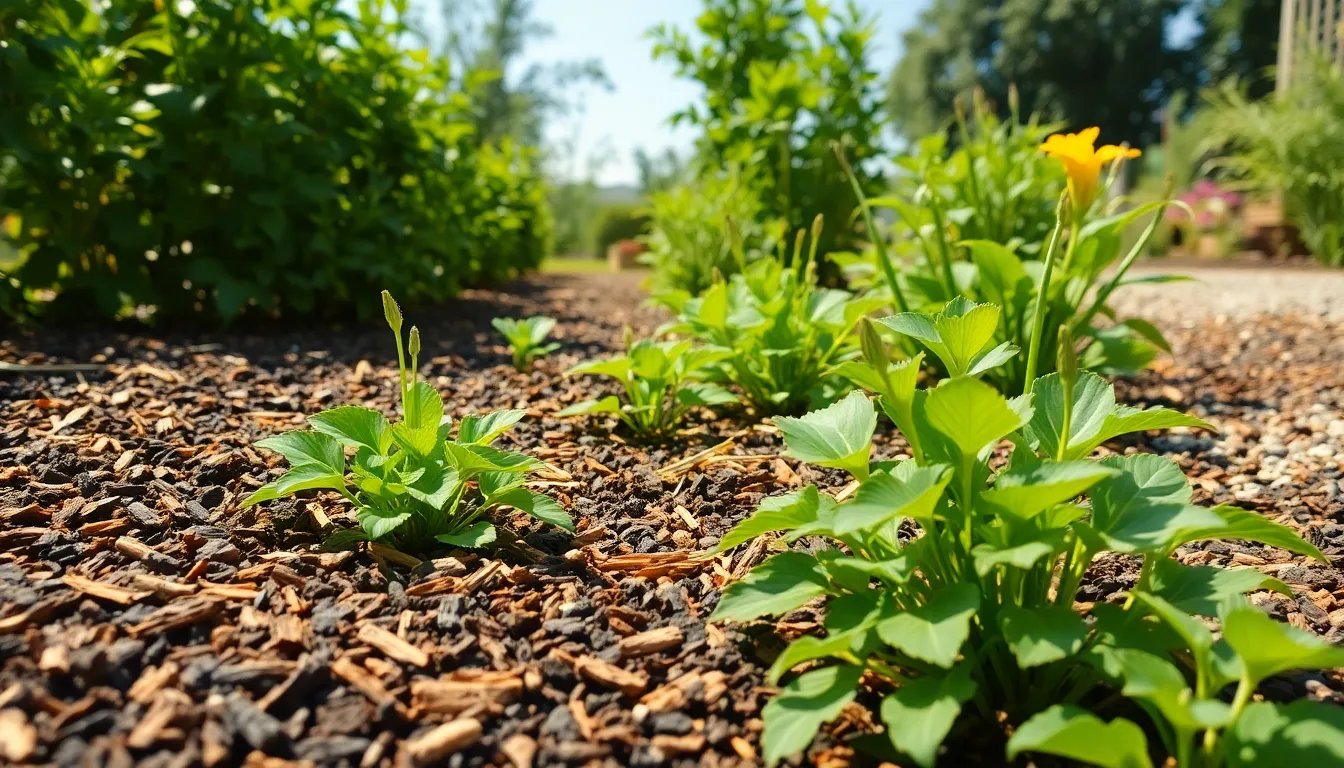
Strategic mulching transforms your irrigation efficiency by creating a protective barrier that conserves moisture and reduces water demands. We’ll explore three distinct mulching approaches that complement smart irrigation systems.
Organic Mulch for Moisture Retention
Wood chips absorb and retain moisture while reducing soil evaporation and runoff, making them ideal companions for drip irrigation systems. These natural materials create an insulating layer that maintains consistent soil temperatures throughout growing seasons.
Straw mulch helps maintain steady soil temperatures while retaining moisture around plant roots. Applying a 2-3 inch layer of straw reduces watering frequency by up to 40% compared to bare soil conditions.
Bark mulch provides long-lasting moisture retention and slowly decomposes to improve soil structure. Shredded bark varieties work particularly well around trees and shrubs where automated irrigation systems operate.
Leaf mold creates an excellent moisture-holding environment that enhances water penetration during irrigation cycles. Composted leaves form a natural sponge that absorbs rainwater and gradually releases it to plant roots.
Inorganic Mulch Options for Water Conservation
Gravel allows water to percolate through while preventing weeds that compete for moisture resources. This permeable mulching option works exceptionally well with soaker hose systems and micro-sprinkler installations.
Black plastic mulch warms soil and retains moisture, proving particularly effective in cooler climates where heat retention maximizes growing seasons. This material prevents water evaporation and directs irrigation water directly to root zones.
Industry fabric provides weed suppression while allowing water penetration from drip emitters and sprinkler systems. Quality fabric options last multiple seasons and reduce overall garden maintenance requirements.
Stone mulch offers permanent moisture conservation with minimal maintenance needs. River rock and decorative stones create attractive garden surfaces that complement automated irrigation installations.
Living Mulch Plants for Ground Coverage
Clover acts as natural mulch while adding nutrients to soil and retaining moisture between irrigation cycles. This nitrogen-fixing ground cover reduces fertilizer needs while providing continuous soil protection.
Creeping thyme provides aromatic ground coverage that helps retain soil moisture around established plantings. This drought-tolerant option thrives with minimal supplemental watering once established.
Sedum varieties create dense moisture-retaining mats that require minimal irrigation support. These succulent ground covers store water in their leaves and release it gradually to surrounding soil.
Vinca minor spreads quickly to form moisture-conserving carpets under trees and in shaded garden areas. This evergreen ground cover reduces water competition and creates attractive year-round garden coverage.
Conclusion
We’ve covered a comprehensive range of irrigation answers that can transform your gardening experience while conserving precious water resources. From simple DIY bottle systems to sophisticated smart controllers these methods offer something for every budget and skill level.
The key to successful garden irrigation lies in matching the right technique to your exact needs. Whether you’re managing containers on a balcony or maintaining acres of industry there’s an efficient solution waiting to be implemented.
Remember that combining multiple approaches often yields the best results. Pairing drip irrigation with mulching strategies or integrating rainwater harvesting with smart sensors creates a synergistic effect that maximizes both water efficiency and plant health.
Start small with one or two techniques that appeal to you then gradually expand your system as you gain confidence and experience. Your plants will thrive while your water bills shrink.
Frequently Asked Questions
What is smart irrigation and why is it important for gardens?
Smart irrigation refers to efficient watering systems that use technology to deliver precise amounts of water to plants when needed. It’s important because it can reduce water consumption by up to 50%, lower utility costs, and create more sustainable gardens while saving time and effort for gardeners.
How much water can drip irrigation systems save compared to traditional watering?
Drip irrigation systems can reduce water consumption by up to 50% compared to traditional watering methods. They deliver water directly to plant roots, minimizing evaporation and runoff while ensuring plants receive the exact amount of moisture they need.
What are the main types of sprinkler systems for larger garden areas?
The main types include oscillating sprinklers for rectangular plots, rotating sprinklers for circular areas, and pop-up sprinkler systems that integrate seamlessly into lawns. Each type provides different coverage patterns and can be enhanced with smart controllers for optimal operation.
How does rainwater harvesting work for garden irrigation?
Rainwater harvesting collects free precipitation through systems like rain barrels, cisterns, and gutter diversion techniques. This collected water reduces municipal water demands and can be integrated with existing irrigation networks, providing a sustainable water source for gardens.
What are self-watering container systems and how do they work?
Self-watering container systems maintain consistent moisture levels in potted plants through reservoir-based planters with wicking systems. These systems draw water from bottom reservoirs, providing steady hydration without overwatering and significantly reducing watering frequency.
Can smart irrigation technology really reduce water usage?
Yes, smart irrigation technology can reduce water usage by up to 30%. Weather-based controllers use meteorological data to optimize watering schedules, while soil moisture sensors prevent overwatering by adjusting irrigation cycles based on real-time ground conditions.
What are some budget-friendly DIY irrigation options?
Budget-friendly options include plastic bottle drip systems, PVC pipe sprinkler networks, and ancient olla (clay pot) irrigation methods. These solutions use common materials to deliver consistent moisture while keeping costs minimal and making efficient irrigation accessible to all gardeners.
How does mulching enhance irrigation efficiency?
Mulching enhances irrigation efficiency by retaining soil moisture and reducing water evaporation. Options include organic mulches like wood chips and straw, inorganic materials such as gravel and landscape fabric, and living mulch plants like clover and creeping thyme that provide ground coverage.

